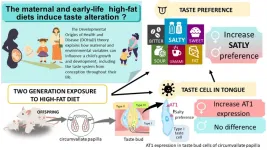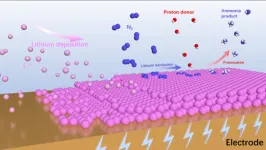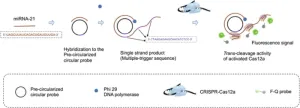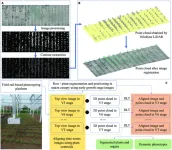(Press-News.org) Researchers at the Johns Hopkins Kimmel Cancer Center identified a novel cell signaling pathway that potentially could be targeted in therapy for patients with aggressive pancreatic cancers.
In laboratory studies with human pancreatic cancer cell lines and genetically engineered mouse models of pancreatic cancer, the investigators discovered that the High Mobility Group A1 (HMGA1) protein functions as a “molecular switch” that “flips on” genes required by tumor cells to grow in an uncontrolled fashion and form invasive tumors. One of these genes activated by HMGA1 leads to the production of fibroblast growth factor 19 (FGF19), which is secreted by tumor cells. FGF19 not only provides signals that coax tumor cells to grow rapidly and invade surrounding tissues, but both HMGA1 and FGF19 cooperate to “build” a dense, fibrous, scar-like wall around the tumor cells, which is known as the stroma. Pancreatic tumors are among a few tumors that form a dense stroma, and the stroma is thought to create a barrier preventing therapy from reaching the tumor cells.
When the scientists silenced HMGA1 or disrupted FGF19 signals in mouse models of pancreatic cancer, tumor cells had markedly decreased growth and less stroma formation, suggesting that drugs to block FGF19 signals already available for use by patients with other diseases could be repurposed to treat pancreatic tumors that have high levels of FGF19. Studies of cancer genomes indicate that up to a quarter of human pancreatic cancers have high levels of HMGA1 and FGF19.
A description of the work was published online March 15 in The Journal of Clinical Investigation.
“Pancreatic cancer is among the most recalcitrant tumors, for which there really are no effective therapies,” says senior study author Linda Resar, M.D., professor of medicine, oncology and pathology at Johns Hopkins. Many patients succumb to pancreatic cancer in six to 12 months of diagnosis, she says, and genomic data indicates that patients with pancreatic cancers with high levels of both HMGA1 and FGF19 have the worse outcomes with even shorter survival than that of other patients with pancreatic cancer.
“In prior work, we found that HMGA1 was overexpressed in most pancreatic cancers and very late stage precursor lesions, as well as in other aggressive tumors such as leukemia and advanced stage myeloproliferative neoplasms, which suggested to us that HMGA1 was playing a fundamental role in driving tumor progression,” Resar says.
In a series of laboratory experiments, Resar and colleagues investigated several methods of disrupting HMGA1 and FGF19. First, they silenced HMGA1 in pancreatic cancer cell lines from primary and metastatic tumors using short hairpin RNA—or artificial RNA molecules that block gene expression—and observed that a deficiency in HMGA1 led to decreased growth rates, impairing migration, invasion and other cancerous properties. They also developed mouse models of pancreatic cancer missing one or two mouse genes for HMGA1 in the pancreas. Surprisingly, loss of just one gene was sufficient to slow tumor formation and progression.
In additional tests, researchers found that FGF19 gene expression, protein levels in pancreatic cancer cells and secretion all depend on HMGA1. Also, silencing FGF19 mirrored effects of silencing HMGA1, decreasing tumor growth and invasive properties. Most importantly, administration of BLU9931, a small-molecule drug that inhibits FGFR4 (a receptor for FGF19), led to decreased tumor growth and stroma formation in mouse tumors.
“Together, we discovered what we believe is a previously undescribed paradigm whereby tumor cells collaborate via HMGA1 and FGF19 to drive cancer progression and stroma formation,” Resar says. “This work also unveiled FGF19 as a potential therapeutic target for a very aggressive subset of human pancreatic cancers. Perhaps the most exciting aspect of our studies is that inhibitors to FGF19 are available and have already been tested in humans.”
In ongoing studies, the researchers are evaluating additional tumors to determine if they upregulate FGF19 and could benefit from treatment with FGF19 blockade. The researchers will also test whether inhibiting FGF19 blocks the spread or metastasis of tumor cells to distant sites.
Study co-authors are Lionel Chia, Bowen Wang, Jung-Hyun Kim, Li Z. Luo, Shuai Shuai, Iliana Herrera, Sophia Chen, Liping Li, Lingling Xian, Tait Huso, Mohammad Heydarian, Karen Reddy, Woo Jung Sung, Shun Ishiyama, Gongbo Guo, Elizabeth Jaffee, Lei Zheng, Leslie Cope, Kathy Gabrielson and Laura Wood.
The work was supported by the National Institutes of Health (grants R01 CA232741, R01 HL145780, R01 DK102943, R01 HL143818 and R03 CA182679), the Allegheny Health Network, the Maryland Stem Cell Research Fund and the Sol Goldman Pancreatic Cancer Research Center.
END
Researchers ID novel treatment pathway for deadly pancreatic cancers
2023-04-24
ELSE PRESS RELEASES FROM THIS DATE:
Maternal and early-life high-fat diets result in a taste for salty food
2023-04-24
Tokyo, Japan – We are all aware of the importance of eating healthy food, especially during pregnancy. A high-fat diet has dramatic consequences on the metabolism. It can lead to obesity, diabetes, chronic liver disease, and possibly cancer. Previous works have demonstrated that eating high amounts of fat during pregnancy affects the taste preference and metabolism in offspring. In most households, children and parents eat the same food. In other words, mums eating a high-fat diet will likely feed their children fatty foods. What are the consequences of maternal ...
NFL PLAY 60 Fitness Break broadcast keeps kids active in advance of the NFL Draft
2023-04-24
DALLAS, April 24, 2023 — The American Heart Association and the National Football League (NFL), in collaboration with its 32 NFL clubs, are challenging kids to move more with an NFL PLAY 60 Fitness Break for the NFL Draft happening later this week. The free program on Wednesday, April 26 at 1 p.m. ET/ 12 p.m. CT/ 10 a.m. PT will offer a 15-minute synchronous broadcast to help students learn how to add movement to their day leading up to the live Draft coverage from Kansas City.
Rooted in American Heart Association science, the Fitness Break broadcast helps students learn more about how physical activity supports ...
A panoramic view on lithium-mediated electrochemical dinitrogen reduction reaction
2023-04-24
The Haber-Bosch process is the industrial approach for NH3 production today, which must be operated at energy-intensive high temperatures and pressures. The reduction of dinitrogen (N2) by electrocatalysis offers an alternative way for NH3 production at ambient conditions and a variety of electrocatalysts have been studied over the past few years. However, even the best catalytic system reported could only get unsatisfied performance (such as the selectivity and production rate of NH3) due to the ...
Unveiling a fast and efficient method for detecting microRNAs
2023-04-24
In the early 1990s, scientists who were studying the development of a roundworm identified a small RNA molecule that regulated the expression of specific genes. This marked the discovery of microRNAs (miRNAs), which are now known to be present across all forms of life. As it turns out, these molecules play essential roles in many biological processes.
A few years later, researchers realized that diseases could dysregulate the expression of miRNAs, highlighting their potential as biomarkers. In fact, abnormal miRNA expression is a hallmark of all tumor-related diseases. Thus, miRNA detection techniques ...
Research sheds light on minimally invasive neurosurgery approach
2023-04-24
Brain tumors located in regions that control speech, vision and motor function present additional challenges to neurosurgeons, as damaging the surrounding tissue can cause severe loss of those abilities.. Because of this, these regions are known as “eloquent brain areas” and require special attention and approaches to limit damage and deficits.
The University of Cincinnati’s Paolo Palmisciano, MD, was part of a research team that examined how well a minimally invasive approach worked to limit vision and hearing loss in patients following brain tumor surgery.
The research was published in the journal Brain Sciences, and the ...
New report makes recommendations on controversial genetics research
2023-04-24
The report, “Wrestling with Social and Behavioral Genomics: Risks, Potential Benefits, and Ethical Responsibility,” produced by The Hastings Center, a bioethics institute, provides direction for research and communications in this area of study with both significant social risks and potential benefits. It is accompanied by an article that describes a fledgling effort to integrate community perspectives on the ethics of this research.
A webinar to launch the consensus report will take place today at 3 PM EST. Register here.
Research on genetic variants and human social and behavioral characteristics, or phenotypes, including anxiety, subjective well-being, ...
Multiple-model GWAS identifies optimal allelic combinations of quantitative trait loci for malic acid in tomato
2023-04-24
The objective of this study is to identify these loci and decipher the polygenic architecture of malic acid content in tomato fruit. The authors carried out a GWAS using six milestone models with two-environment repeats. A series of associated SNP variations were identified from GWAS, and 15 high-confidence annotated genes were obtained based on the lead SNPs and the malic acid accumulation. The optimal allelic combination of the 15 loci was presented for tastier tomato. ...
120-year-old storm’s secrets key to understanding weather risks
2023-04-24
A severe windstorm that battered the UK more than a century ago produced some of the strongest winds[OS1] that Britain has ever seen, a team of scientists have found after recovering old weather records.
Old weather measurements, first recorded on paper after Storm Ulysses hit the UK in February 1903, have shed new light on what was one of the most severe storms to have hit the British Isles.
By turning hand-written weather data into digital records, the research team has laid the way to better understand other historical storms, ...
New phenotyping approach analyzes crop traits at the 3D level
2023-04-24
The steady decline in cultivable land owing to the rapidly increasing global population has necessitated the use of efficient plant breeding methods that could be used to improve agricultural yields. However, in addition to genetic methods, we need approaches to control and improve complex crop traits. To this end, plant scientists make use of various cutting-edge imaging techniques that quantify crop traits (height, leaf shape, leaf color, etc.). Traditional imaging methods, however, are tedious, destructive, and non-sustainable. ...
Masashi Watanabe to receive 2023 Microanalysis Society Presidential Science Award
2023-04-24
Lehigh University materials science and engineering (MSE) professor Masashi Watanabe is the 2023 recipient of the Microanalysis Society Presidential Science Award, which recognizes a senior scientist for “outstanding technical contributions to the field of microanalysis over a sustained period of time.”
Watanabe is a Fellow of the Microanalysis Society and a former MAS president. The career achievement honor highlights his work in advancing quantitative analysis in scanning transmission ...








